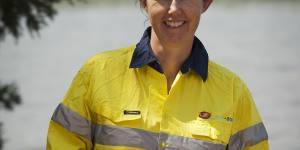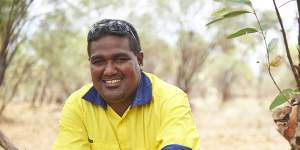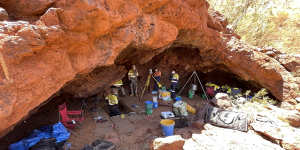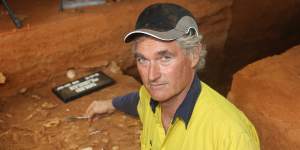“The cave was like a home,you know?” says Yinhawangka elder Stuart Injie jnr,who has sat contemplating that view,like his father Stuart snr before him,at the cave they call Yirra. “It’s where people could stay,like an upstairs apartment where you could stay through the seasons – in summer it would be cool and in winter it would be warm. You could feel at home,even today.”
This single cave has yielded some of the earliest evidence of Aboriginal peoples’ occupation of the Australian desert,with sediments bearing artefacts dating back more than 50,000 years. There are well-preserved fire hearths around which the ancestors of the Yinhawangka people gathered for warmth and sustenance. But for a long time,Yirra was doomed to destruction,a site known to mining executives and bulldozer operators as a cluster of map coordinates on Rio Tinto’s Channar mine.
Its survival would be inextricably linked to the fate of Juukan Gorge,the at another West Australian Rio Tinto mine site. Both Juukan and Yirra caves,which lie 100 kilometres apart in the remote iron ore-rich Hamersley Ranges,are among dozens of sites that archaeologists say are key to rewriting the prehistory of Australia.
Yirra is an intriguing tale of what was so nearly lost,and why the nation’s heritage laws still fail. It began when archaeologist Fiona Hook and four traditional owners from Yinhawangka Aboriginal Corporation (YAC) were allowed into an area of Channar mine in 1999 to conduct compliance work prior to destruction.
“Rio Tinto needed to see what was in the path of their mine extension,” recalls Hook,a veteran of mine work with her archaeologist husband,Bruce Veitch. The pair had conducted dozens of compliance surveys,walking up gullies and across plains to systematically inspect every potential Indigenous site. They lived with the almost certain knowledge that any significant find would be recorded,objects salvaged and the site destroyed as mining activity moved in.
On the day Hook,Veitch and others including Stuart Injie’s father scrambled up a scree slope to reach Yirra,they quickly noticed a couple of stone tools that looked like small sharp flints on the dirt floor inside. Injie snr was excited – he and the other Yinhawangka elders declared they wanted the cave further investigated. Hook lodged an application under the WA Aboriginal Heritage Act to investigate the site for research purposes. Rio agreed and gave them permission to go on site,which they did a few months later.
“I went ahead to set up the pins to mark out the excavation inside the cave,” recalls Hook. “Usually,it’s very difficult to insert the pins,but all eight pegs went in like a hot knife in butter. I went back to the others and said,‘This is a very different site.’ ”

Archaeologist Fiona Hook calls Yirra “a once-in-a-lifetime discovery”.Supplied
In the first five centimetres of sediment scraped back with trowels,the party uncovered layer after layer laden with clues to human presence. “We found charcoal from many individual campfires and around them stone tools,cutting implements and even the debris that goes with it.”
Miraculously,the sequence of layers had not been churned up by kangaroos or washed out by rainwater;each was as neatly laid down as when it first settled on the cave floor. “Such sites are incredibly rare,” says Hook. “No disturbance,no roof fall,masses of cultural material.” It dawned on them that hundreds of family generations had made this cave their home. “Each was a little campfire hearth from a different era. People had repeatedly come back to this one little rock shelter in a gully in Paraburdoo.”
They collected charcoal samples and sent them off for radio-carbon dating;the oldest date came back at 23,000 years. “It was all very exciting,a once-in-a-lifetime discovery for someone like me working in the Pilbara,” says Hook. “Most of the sites we excavate are 1000 or 2000 years old,or 5000 years if you’re lucky.”
The group had stumbled across a popular “drop-in centre” where even at the height of the last Ice Age around 22,000 years ago,when Australia’s north-west desert climate became up to 6 degrees colder,people were clearly inhabiting the Pilbara desert uplands. It posed a tantalising question – would a full-scale excavation,probing another 40 to 50 centimetres of sediment,yield even greater antiquity? Hook and her husband were convinced Yirra was far older than the charcoal record,perhaps even 35,000 years old. “That would have made it one of the oldest sites in the Pilbara.”
More than half the land surface in the Pilbara region is under mining leases. Like many heritage sites,Yirra was destined to disappear beneath a road for ore-carrying trucks. Hook alerted Rio’s heritage manager to the dating results;he informed the mine excavation planners and Yirra’s destruction was put on hold.
“Rio did the right thing,” says Hook. “But then,when I and the Yinhawangka people asked repeatedly to go back and properly excavate the site,they said no.” For the next 20 years,their pleas to return to Yirra fell on deaf ears. “Whenever I saw the elders,they’d all say,‘We need to get back to that place,the one we excavated with you and Bruce.’ But Rio wasn’t interested.”
The impasse continued. Meanwhile,YAC hired its own heritage adviser,Anna Fagan. “Traditional owners kept talking about this remarkable place that they desperately wanted to go back to,” Fagan recalls. “Yirra was absolutely a priority for the corporation,not just for the story of archaeology in the Pilbara but for the Yinhawangka people,who had requested it time and time again.”
Fagan had arrived in WA after working in Europe and the Middle East on archaeological sites. “I was shocked to discover the cultural heritage standards of Syria,Iraq,Iran and Turkey are fundamentally well above those of Western Australia. Here there’s a relentless drive for resources,industry and development – it’s like an entire state is suffering from Stockholm syndrome.”
On May 24,2020,a remote cave system at Juukan Gorge was blasted away by Rio Tinto to make way for mine expansion. Juukan resembled Yirra in some ways;the Puutu Kunti Kurrama and Pinikura peoples had occupied the caves for possibly 46,000 years,a figure estimated from an earlier salvage mission that retrieved stone artefacts,faunal remains and even preserved human hair from the caves.
Rio had received state government permission to destroy Juukan in order to extract $135 million worth of iron ore. Yet its destruction sent ripples around the world. For the first time,questions were asked about why the wishes of Australia’s Indigenous people to preserve globally significant sites were ignored. The lack of suitable answers ended the careers of Rio Tinto’s chief executive Jean-Sébastien Jacques and two other senior executives,and led to a joint parliamentary committee investigation into the disaster.
Juukan’s destruction proved to be the salvation of Yirra. Sensing opportunity,the YAC renewed their longstanding demand to revisit the cave,and submitted a detailed budget to Rio for state-of-the-art dating and training of local people in excavation techniques. It was rejected as too expensive until,in October 2021,Rio gave permission and the money needed to conduct the science and have the corporation direct the work.
It was a bittersweet victory after a 20-year delay,during which time several Yinhawangka elders had died and Hook’s husband Bruce Veitch had been diagnosed with motor neurone disease. “He died 10 months later,” says Hook,“and I became a single parent and sole company director trying to earn a wage to support my family.”
Within a month of Rio’s change of heart,Fiona Hook was back at Yirra with eight Yinhawangka members,Rio heritage officers and Peter Veth,professor of archaeology,and his team from the University of Western Australia. It was an emotional reunion for some – three generations making up for lost time. “I was now working with our 18-year-old son Conall and some grandkids of the elders that Bruce and I had worked alongside,” says Hook. “We had an intergenerational connection,special and unique.”
The connections to country were also deeply personal. Yinhawangka man Stuart Injie jnr asked to join the group “because my dad Stuart senior was on the original trip. Going back there,you could feel a spiritual feeling that was welcoming. An old fella[in the group] talked aboutngurra[a place of belonging]:‘We’re the locals on our country and we’re not here to do any harm.’ ”

Yinhawangka elder Stuart Injie jnr says the cave was “like a home”.Supplied
For Nancy Tommy,it was an emotional family pilgrimage – on behalf of sister Julie and brother Roy – to where their grandfather William Jiwalangu was born,a birth site they called Nanjarrakari that lay a short distance from Yirra.
For 10 days,Veth led the excavation that dug down to more than a metre below the cave floor. “As we went down centimetre by centimetre,I realised we were looking at at least a 40,000-year record,” he recalls. “Then we went even deeper and found artefacts towards the base of the rock shelter – we were looking at real antiquity.”
Veth had advised the Yinhawangka that they needed to use new technology at the University of Wollongong that could identify far older dates than using charcoal samples. Called optically stimulated luminescence,or OSL,it can analyse grains of sand buried around artefacts and measure the last time the sand had been exposed to sunlight.
“Imagine 40,000 years ago a group of mums and dads and kids come into the rock shelter,” explains Hook,herself a mother of two. “They light a camp fire and make some stone tools and cook up a feed on a layer of sand. Then the people disappear for 100 years and a deposit builds up over the top of it,sealing sand grains into that layer.”
Sand grain samples were collected and sent to University of Wollongong professor Zenobia Jacobs. In March last year,she released the OSL results to Hook. “They came through at 8.30pm on a Friday night,” says Hook. “I was at home and I’d been checking my emails pretty much every hour. I screamed when I looked at the dates – one 50,000 years old and one older. My kids came running,and when I told them they said,‘That’s great Mum’ and went back to their bedrooms. And then I couldn’t get anyone on the team to answer their phones!”
The next day,she contacted the Yinhawangka elders and told them the cave was now the oldest known site in the Pilbara. “It was very emotional. They know how deep their connection to country is,and science told a version of that story.”
Rio Tinto iron ore chief executive Simon Trott released a joint statement with the Yinhawangka people. “We acknowledge the significance of Yirra and are committed to working in partnership with the Yinhawangka people to ensure it’s preserved for future generations,” he said,adding,“Rio Tinto is planning to fund further traditional owner-led cultural research and archaeological excavations.”
YAC chair Halloway Smirke had a terser message. “We would still be visiting this site if it wasn’t for the mining leases. All Pilbara groups should have this kind of science work done on cultural sites. Important sites like Yirra need to be protected,especially when they turn out to be amongst the oldest known places of human habitation in Australia.”
Hook’s own feelings about her extraordinary career highlight were mixed. “I know how excited Bruce would have been to be there. He was an amazing archaeologist,so well-loved by the traditional owners.” She had been the last person to leave Yirra cave after the dig was over. “I wanted to make sure that it looked as if we’d never been there. I sat on a rock and had a bit of a cry – we’d finally managed to go back after so long.”
The little cave that was almost lost now ranks among the oldest known habitation sites in Australia,and one of the nation’s most ancient desert sites. It will help rewrite chapters in the deep history of the country,says Professor Peter Veth,and shed light on Aboriginal people’s resilience over time. Analysis of the site contents continues,including the dating of duplicate samples taken from the excavations by the Wollongong lab.
“This work is not fast and we cross-check everything,not least the association of the artefacts,their cultural context and their final dating,” says Veth. “Only then and by the end of this year will the final results be available through a range of peer-reviewed papers,plain language reports and a short film made during the excavation.
“I think it’s very likely that Yirra and other desert places will eventually prove to be up to 60,000 years old – that’s before modern humans get to Europe. It’s a unique global record. Remember that the earliest rock art and cave occupation in France and Spain for modern peoples sits in the 42,000-year range. One reason we got so excited is because,until about 10 years ago,there were very few Ice Age records in the deserts of Australia. It’s only by precise description of sediments and new ways of dating that we now know people were definitely there during the last glacial period,and that’s a major revision.”

The Yirra rock shelter excavation. “The Pilbara probably has hundreds of sites,but we’re still in scramble mode,” says professor of archaeology,Peter Veth.Supplied
Australia’s story of desert occupation and many more rock shelter sites like Yirra will be revealed over the next five years. Last August,a few months after the Yirra news,Veth was awarded a prestigious Australian Laureate Fellowship to conduct a $3.2 million project called Desert People:Australian Perspectives. It will bring together multi-university teams of scientists and Indigenous knowledge;the aims,project literature explains,are “to develop new understandings of the 60,000-year custodianship of Australian deserts” and “to avoid another incident and loss like the Juukan caves”.
Expeditions are planned from edge to interior – from the Ningaloo coast to sites located deep in the Pilbara and Western Desert,where “the globally significant human record is poorly documented and at risk”.
“Despite tens of billions of dollars in mining profits,we still scrabble to document,record and protect cultural heritage.”
Peter Veth,professor of archaeology
Says Veth,“It’s one of the biggest projects of its kind,but if we hadn’t got the grant,we wouldn’t be doing it. There used to be more state archaeology done like ours,but that effort has been scaled back. The state institutions now largely deal with site inspections,public education and collections. It means the critically needed assessment of site significance,like the Yirra excavation,falls on to mining compliance and linked mitigation. There must be more heritage work supported by the state,industry and the universities to discover and celebrate our outstanding heritage values. This is what traditional owners want and what Western Australia needs to do to become an internationally benchmarked heritage regime.”
The firstDesert People expedition was completed just weeks ago. Veth and his team visited sites near mining activity;they were taken by traditional owners to extraordinary caves where items such as clay pipes,wooden dishes,ochre,vast numbers of artefacts and intact fireplaces lay on the ground. They can’t yet be identified publicly but,according to Veth,some of these sites have the potential to be of national or even global significance.
“There are many more Yirras out there and we need to know where they are,” he says. “The Pilbara probably has hundreds of sites that have significant value,but we’re still in scramble mode – despite tens of billions of dollars in mining profits,we still scrabble to document,record and protect cultural heritage.”
Last November,Environment Minister Tanya Plibersek laws were necessary and should be co-designed with First Nations people. “There’s absolutely a sense of urgency to ensure that this sort of cultural heritage destruction doesn’t happen again,” she told ABC radio.

Peter Veth says the findings at Yirra will help rewrite the deep history of the country.Courtesy of The University of Western Australia
Meanwhile,in WA,new heritage laws came into effect this month. The controversial permit sought routinely by mining companies to destroy sites like Juukan Gorge,called a section 18,has been abolished. Veth is hopeful that the state’s revised Aboriginal Cultural Heritage Act will better protect newly discovered sites of early occupation such as Yirra. “However,although the permit to destroy sites is gone,the state heritage minister still retains executive power to override these values,” he says,adding that protection is certain only if the site is declared a protected area.
The catch is that the final decision lies with the minister,although advice is received from a new Indigenous-led Aboriginal Cultural Heritage Council. “So effectively,the minister of the day is still in the driver’s seat,” notes Veth.
Australia also faces a chronic shortage of heritage consultants to do the critical work for both companies and Aboriginal corporations. “The point is that we need basic standards for heritage documentation,” says Veth. “Our federal heritage laws have not been brought up to standard and all the advice we gave on Juukan,like adopting a cultural landscape approach that better equates to an Aboriginal understanding of country,has not been acted on yet,either at state or federal level.”
Anna Fagan says Yirra should become the blueprint for how research work is done. “At the moment,the standard practice in rock shelters across the Pilbara and WA is to fund just one test excavation trench. But digging one trench in a massive rock shelter is like lifting up a single tile in your bathroom to understand the story of your house. It doesn’t give you the full picture,especially the time depth. We need to work across the Pilbara,across Australia,and conduct these large,comprehensive excavations of those places in the pipeline for destruction.”
Last December,Indigenous Australians Minister Linda Burney said:“There is no doubt that won’t happen again.” Meanwhile,Rio has permitted Juukan’s cave floor to be re-exposed after tonnes of surface rubble were removed;under tarpaulins,attempts will be made to retrieve key material.
Yet Yirra is still not safe,and the Yinhawangka elders require a permit and escort to visit the site. The iron ore has nearly been exhausted and Rio has submitted a formal closure plan to the state government. A Rio Tinto spokesperson says Rio “is committed to the long-term protection of the Yirra rock shelter”. The site will be subject to planning and engineering design and its protection will form part of the winding up of Channar mine.
Stuart Injie feels upset to see the 110-metre-high man-made land bridge that still looms above the cave entrance. “A couple more big cyclones and that land bridge is going to[be] washing it all out. You can see it falling down there,dirt coming down. This is an important site,what’s it doing here? That place is now a part of us,so I want to see it protected. It’s part of all of us.”
The question hanging over Yirra and many sites of Australia’s prehistory is why their fate is still largely dictated by a company,not government or a heritage body. It’s a question for which Fiona Hook has heard no satisfactory answer. “It’s been a torrid time for Indigenous people and archaeologists in Western Australia,and we’ve been made to feel like pariahs,” she says. “We’re always fighting for the scraps.”
To read more from Good Weekendmagazine,visit our page at, and
